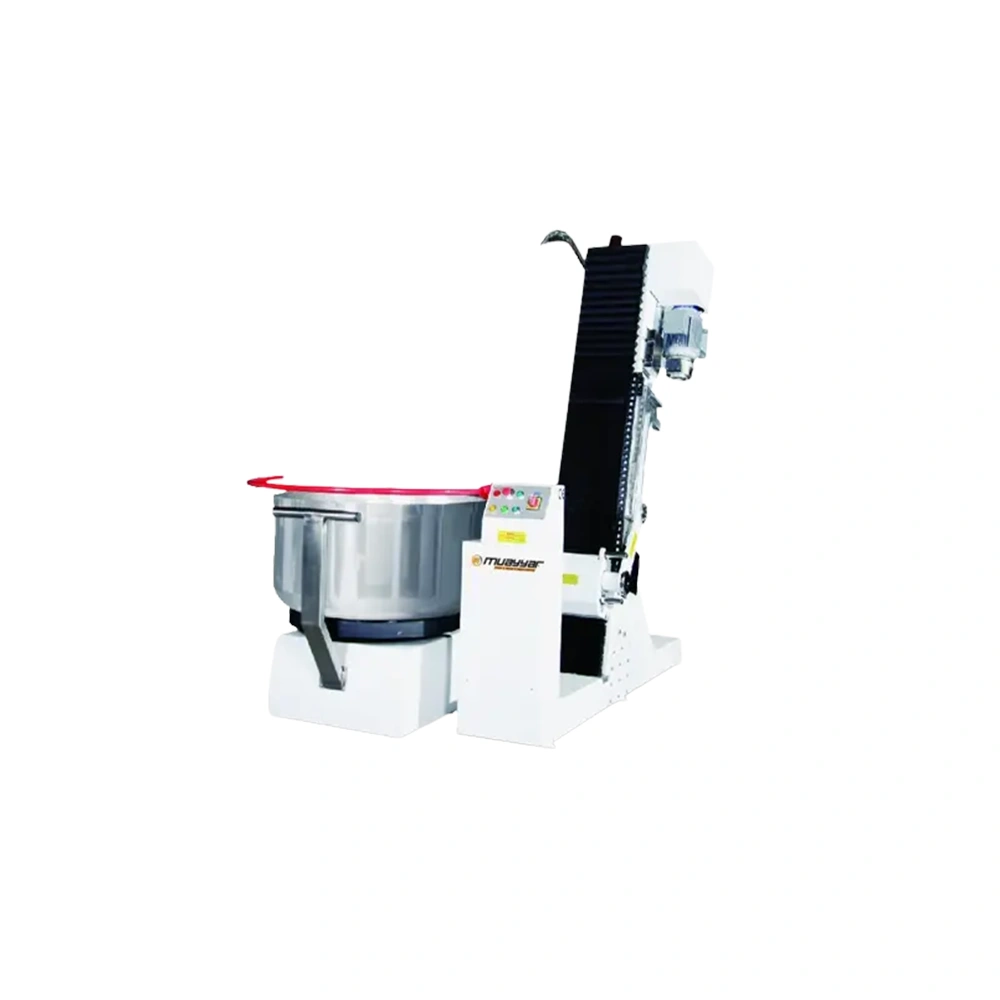Dough Bowl Lifting-Tilting Machine
Technicial Specifications
| Unit | MSKD 100 | |
| Dough Capacity | kg | 160-250 |
| Dough Cast Height | mm | 1600-1900 |
| Maximum Height (H1) | mm | 2900 |
| Width | mm | 1600 |
| Length | mm | 2220 |
| Height | mm | 2350 |
| Elektric Power | V | 380 |
| Motor Power | kw | 2,5 |
| Weight of Machine | 750 |
Dough bowl lifting-tilting machines are essential in large-scale bakeries, streamlining dough handling and ensuring efficiency. Let’s delve into the details of these machines.
Understanding Dough Bowl Lifting-Tilting Machines
Dough bowl lifting-tilting machines are specialized equipment designed to handle large quantities of dough in commercial baking operations. These machines feature a robust frame with a lifting mechanism that hoists heavy mixing bowls, allowing for effortless transfer of dough to other processing equipment or workstations. The tilting function enables precise control over the pouring of dough, enhancing efficiency and minimizing manual handling.
Key Components and Mechanisms
- Lifting Mechanism: The lifting mechanism consists of hydraulic or electric actuators that raise and lower the mixing bowl. This feature simplifies the loading and unloading of dough, reducing strain on bakery staff and improving workflow efficiency.
- Tilting Mechanism: The tilting mechanism allows the mixing bowl to be tilted at various angles, facilitating controlled pouring of dough into dividers, moulders, or other equipment. This precise pouring capability ensures uniform dough distribution and minimizes waste.
- Control Panel: Dough bowl lifting-tilting machines are equipped with user-friendly control panels that allow operators to adjust lifting and tilting speeds, as well as set customizable programs for different types of dough and production requirements.
- Safety Features: To ensure operator safety, these machines are equipped with safety interlocks and sensors that prevent operation when the bowl is not securely in place or when safety guards are open. Emergency stop buttons provide an additional layer of safety during operation.
Advantages of Dough Bowl Lifting-Tilting Machines
- Efficiency: By automating the lifting and tilting of mixing bowls, these machines significantly reduce manual handling and labor requirements in the bakery, resulting in improved productivity and throughput.
- Precision: The ability to precisely control the lifting and tilting functions allows for accurate pouring of dough, minimizing spillage and ensuring consistent product quality.
- Versatility: Dough bowl lifting-tilting machines are compatible with a wide range of mixing bowls, making them suitable for various batch sizes and types of dough.
- Space-saving: These machines are designed to optimize space utilization in the bakery, with compact footprints that minimize floor space requirements.
Applications in Commercial Bakeries
Dough bowl lifting-tilting machines are essential in large-scale commercial bakeries where efficient dough handling is paramount. They are used for transferring dough from mixers to dividers, moulders, or other processing equipment, as well as for emptying dough into storage containers or forming stations.
Dough bowl lifting-tilting machines are invaluable assets in commercial bakeries, offering efficiency, precision, and versatility in dough handling. With their advanced features and user-friendly design, these machines streamline production processes, reduce labor costs, and ensure consistent product quality, making them indispensable tools in modern bakery operations.
In summary, dough bowl lifting-tilting machines are essential equipment for bakeries seeking to enhance efficiency and productivity in dough handling and processing.
Certainly, let’s continue exploring dough bowl lifting-tilting machines in further detail.
Maintenance and Cleaning
- Easy Maintenance: Dough bowl lifting-tilting machines are designed for ease of maintenance, with accessible components and minimal complexity. Regular maintenance tasks include lubrication of moving parts, inspection of hydraulic or electric systems, and cleaning of surfaces to ensure optimal performance and longevity.
- Hygienic Design: These machines are constructed with materials that meet food safety standards, such as stainless steel, which is resistant to corrosion and easy to clean. Smooth surfaces and removable parts facilitate thorough cleaning and sanitation, minimizing the risk of contamination in the bakery environment.
Customization and Integration
- Customizable Options: Manufacturers often offer customizable options to tailor dough bowl lifting-tilting machines to specific bakery requirements. This may include adjustable lifting and tilting speeds, different bowl capacities, and compatibility with various mixing bowl sizes and types.
- Integration with Production Lines: Dough bowl lifting-tilting machines can be seamlessly integrated into existing production lines or used as standalone units, depending on the bakery’s layout and workflow. Integration may involve connecting the machine to dividers, moulders, or other downstream equipment for continuous dough processing.
Safety and Compliance
- Safety Standards: Manufacturers prioritize safety in the design of dough bowl lifting-tilting machines, adhering to industry standards and regulations. Safety features such as interlocks, emergency stop buttons, and safety guards ensure operator protection during operation.
- Compliance with Regulations: These machines are designed and manufactured to comply with relevant safety and sanitation regulations, such as those set forth by organizations like the Occupational Safety and Health Administration (OSHA) and the Food and Drug Administration (FDA) in the United States, as well as international standards.
Cost Considerations
- Investment vs. ROI: While dough bowl lifting-tilting machines represent an initial investment for bakeries, they offer significant returns in terms of labor savings, increased productivity, and consistent product quality. The long-term benefits often outweigh the upfront costs, making them a worthwhile investment for bakery businesses.
- Budgetary Planning: Bakery owners and managers should consider factors such as production volume, space constraints, and budgetary constraints when evaluating the cost-effectiveness of dough bowl lifting-tilting machines. Assessing the total cost of ownership, including maintenance and operational expenses, is essential for informed decision-making.


Reviews
There are no reviews yet.